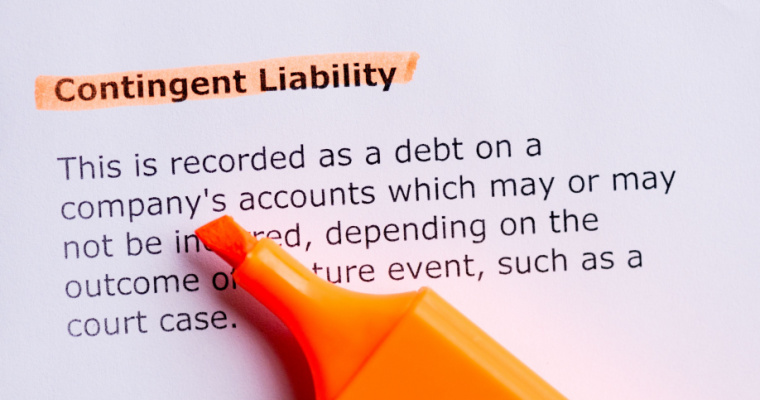What is Contingent Liability? – Defination, Types and Examples

What is Contingent Liability?
A contingent liability is a potential loss or liability that may occur in the future depending on the outcome of a specific event. Some examples of contingent liability include potential lawsuits, product warranties, and ongoing investigations
In most cases, contingent liabilities are disclosed in a company’s financial statements, along with an estimate of the potential impact on the company’s financial position if the liability becomes actual. This is due to the fact that they can have a substantial impact on a company’s financial health even if they are not currently reflected on its balance sheet.
Contingent Liabilities Example:
- Product Warranties: If a company provides warranties for its products, it may be required to repair or replace them if they fail during the warranty period. This potential liability is contingent on the failure of the product.
How Contingent Liabilities Work?
The accounting rules for reporting a contingent liability vary depending on the liability’s estimated amount and the likelihood of the event occurring. Accounting rules ensure that readers of financial statements receive adequate information.
Types of Contingent Liabilities
1. Probable Contingency
Any financial obligation that has at least 50% chance of occurring in the future is considered a probable contingency, and the loss thus to be realised is considered as a probable contingent liability.
For example, a company might face a contingent liability if it is involved in a lawsuit that has not yet been resolved. The outcome of the lawsuit is uncertain, but if the company loses, it may be required to pay damages to the plaintiff, which would become an actual liability.
2. Possible Contingency
A possible contingency occurs when a liability may or may not occur, but the likelihood of its occurrence is less than 50% of that of a probable contingency. As a result, a potential contingency is usually mentioned in the footnotes rather than recorded in the books.
3. Remote Contingency
A remote contingency is any liability that has a low probability of occurring and is not possible under normal circumstances as the likelihood of such contingencies resulting in losses for the company is remote, they are not recorded in the books or mentioned in footnotes.
Importance of Contingent Liabilities for Investors and Creditors
Knowing about contingent liability can affect an investor’s decision because it can have a negative impact on a company’s cash flow, future net profitability, and assets and may dilute an investor’s interest in the company.
That’s because contingent liability puts a company’s future profit making potential at risk. The size of the liability and the specifics of the potential contingency may also influence an investor’s choice.
Similarly, being aware of contingent liability may affect a creditor’s decision to extend a loan to a business. The company’s ability to repay its debt could be negatively impacted if the contingent liability materialises into an actual liability.
Examples of Contingent Liability
Given below are a few examples of contingent liabilities:
1. Letter of credit issued by a business
2. Judgements passed against the concerned business in case of a legal dispute
3. Changing government policies
4. Product warranties that companies give to their customers.
5. Guarantees that the company gives to stakeholders on behalf of their third party (which could be done as a part of fulfillment of their contract)
Classification of Contingent Liability
According to GAAP (Generally Accepted Accounting Principles), there are three different categories of contingent liabilities: Probable, Possible, and Remote.
1. Probable Contingent Liabilities
Estimable contingent liabilities with a high probability of occurrence are known as probable contingent liabilities, which must be reflected within financial statements.
2. Potential Contingent Liabilities
They are obligations that may or may not arise in the future and have to only be disclosed in the financial statement footnotes.
3. Remote Contingent Liabilities
They are obligations that are very improbable to occur and do not need to be included in the financial statements at all.
How to Recognise a Contingent Liability?
Contingent liability has a broad definition, making it difficult for businesses to rule out or include a contingent liability in their books.
So it is always recommended that businesses consult professionals who are expert about the subject. Companies can follow GAAP rules while also having a solid argument when being audited.
For example, if a company is facing litigation, it should consult a lawyer and rely on his or her discretion when it comes to including or excluding a liability from the books.
Impact of Contingent Liabilities on a Company’s Share Price
Contingent liabilities are likely to cause a company’s stock price to drop. This is due to the fact that such liabilities put the company’s future ability to make profits at risk.
The company’s financial health matters in this kind of situation. Investors may decide to invest in a company regardless of contingent liabilities if they think the company’s financial position is solid enough to absorb any losses that may result from such liabilities. A contingent liability may not significantly affect a strong and stable company’s stock price.
Other important factors to take into account include the type of contingent liability and the risk attached to it. Also, a short-term liability is more likely to affect a company’s share price than a long-term liability that won’t be resolved for years (as there is a chance that these liabilities won’t occur if the settlement takes a long time).
How Does Contingent Liability Affect Investors?
When a company recognises the possibility of a loss in advance, it has the opportunity to make provisions for such losses, attempting to mitigate the impact of such future loss. However, this is not the reason for recording a contingency as a liability on the books.
Rather, when a contingent liability is recorded in a company’s books, that information is made available to shareholders and auditors. As a result, registering a contingent liability can be interpreted as protecting shareholders from potential losses.
To protect investors’ interests, all probable contingent liabilities (chances of occurrence of at least 50%) must be recorded in a company’s books. It enables people to make sound investment decisions.
Issues of Contingent Liability
- The accounting rules for the treatment of contingent liabilities are quite liberal; therefore, unless the risk involved is very high, there is no need to record them.
- In order to determine whether any additional risks have not yet been recognised, one should carefully go through the disclosures that are included with a company’s financial statements.
- The disclosures are to be viewed as a heads-up regarding amounts that might subsequently appear as formal liabilities in the financial statements.
- A company is not required to set aside funds to cover such liabilities when recording them; therefore, recording these liabilities does not affect the firm’s cash flow.
What is a Contingent Liability in Accounting?
Any contingent liability will be recorded in the books of accounts if the contingency is probable and the corresponding amount can be accurately estimated. GAAP requires contingent liabilities to be recorded because of its connection to the following 3 accounting principles:
1. Full Disclosure Principle
A contingent liability has the potential to have a negative effect on a company’s financial performance and overall health because it poses a threat to the assets and net profitability of the organisation.
In line, the full disclosure principle states that all material information about a company’s financial position and fundamentals should be included in the financial statements. And thus, in accordance with this principle, all events or circumstances that may monetarily impact a company must be disclosed in its financial statements.
2. Materiality Principle
A contingent liability can affect how different users of the company’s financial statements make decisions.
According to the materiality principle, all significant financial data and issues must be disclosed in the financial statements.
A factor is deemed material if it has the potential to affect how users of a company’s financial statements make financial decisions. The words “material” and “significant” are practically interchangeable in this context.
3. Prudence Principle
A key accounting concept called ‘prudence’ ensures that liabilities and expenses are not understated while assets and income are not overstated.
Since it is impossible to predict the outcome of contingent liabilities, the likelihood that the contingent event will occur is estimated, and if it is greater than 50%, the liability and its related expenses are recorded.
Also Read
Difference Between the Various Types of Liabilities
| Non-Current Liabilities | Current Liabilities | Contingent Liabilities |
| A company’s financial obligation that can be paid off in a year | A Company’s financial responsibility that needs to be written off in a year | A company’s financial obligation which may or may not arise in the future depending on the result of a specific situation |
| These liabilities are written in the balance sheet | These liabilities are recorded in the balance sheet | If a contingent liabilities has a 50% or higher chance of being realised, it is posted in the Profit and Loss Account as well as the balance sheet. |
| E.g Mortgage Loans, Bonds, | E.g Tax liabilities, Bank overdraft, Outstanding Payments, Creditors | E.g Lawsuits, Warranty , Investigation. |
Final Word
A company should approach contingent liabilities cautiously as they may directly impact investors, creditors, and stock price. Potential lenders to a company also take liabilities into consideration before deciding their lending terms.
If you are interested to know more about mutual funds that can help you diversify your investment portfolio and maximise your returns potential, here’s a tip. Try investing in Navi Mutual Fund schemes, starting at just ₹10 and get exposure to top Indian and foreign companies with just a few clicks. To check out our products, download the Navi App today
FAQs
Contingent liabilities are the liabilities which are dependent upon a future event and may or may not materialise later. Future occurrences determine whether a contingent liability for the company becomes an actual liability.
Letter of credit issued by a business, lawsuits, changing forex and government policies, product warranties, etc., are some apt examples of contingent liabilities.
According to GAAP, there are three types of contingent liabilities – Probable, Possible, and Remote.
Accounting standards specify the disclosure requirements for contingent liabilities. Companies must generally disclose the type of contingency and the anticipated timing and amount.
Companies, through sufficient insurance coverage and established reserves, can reduce the risks related to contingent liabilities.
The seller or manufacturer may be held liable and responsible for warranty costs if a service or product does not live up to the terms of a warranty. Product warranty is a type of contingent liability that is both probable and estimable in the context of accounting.
As a result, at the time of sale, a business must record the anticipated costs for replacement or repair during the warranty period. This is shown as a liability on the balance sheet and as an expense on the income statement.
The term “warranty liability” refers to a financial obligation that is recorded to pay for the cost of potential future claims resulting from product warranty agreements.
A provision is a present liability resulting from a past event. A contingent liability is a liability that may or may not occur in the future. A provision’s estimated amount is unknown. The contingent liability’s estimated amount is certain.
A contingent liability is recorded first as an expense in the Profit & Loss Account and then on the liabilities side in the Balance sheet.

Customer’s Feedback
No comments found.Types of Fixed Deposit in 2023 – Know Different Types of FDs and How to Choose
Fixed deposits (FDs) are a popular investment option offered by banks and other financial instituti... Read More »10 Best National Pension Schemes (NPS) in India in April 2023
National Pension Scheme (NPS) is a retirement benefits scheme launched by the Government of India f... Read More »National Pension Scheme (NPS) – How to Open NPS Account?
National Pension Scheme or NPS is a voluntary contribution-based retirement benefits scheme introdu... Read More »How to Open an NPS Account Online and Offline?
National Pension Scheme The National Pension Scheme (NPS) is a voluntary retirement savings sche... Read More »Mahila Samman Savings Certificate Scheme -Interest Rate, Benefits and Eligibility
The Mahila Samman Savings Certificates, a fixed-income investment programme explicitly launched for... Read More »What is a Tax Saving FD – Interest Rates, Benefits, Features and Calculation
Did you know that tax-saving FDs (fixed deposit) can help you save up to Rs.46,800 on taxes? Consid... Read More »What is Fixed Deposit – Best FD Interest Rates, Calculations and How to Apply Online
Fixed deposits (FDs) are known to offer guaranteed returns - one of the reasons why they are so pop... Read More »EPF Interest Rate 2023 – 8.15% FY 2022-23
The Employee Provident Fund (EPF) is a Government-backed retirement savings scheme directed towards... Read More »12 Best Investment Plans in India in April 2023 – Returns & Benefits
Working extra hard to earn money? Great! But, how about making your money work as well? Yes, we are... Read More »Sukanya Samriddhi Yojana: Bank Interest Rates and How to Open a SSY Account
Honourable Prime Minister Narendra Modi launched SSY (full form - Sukanya Samriddhi Yojana) as an i... Read More »Senior Citizen Savings Scheme (SCSS) – Interest Rate 2023
The Senior Citizen Savings Scheme is a government savings scheme launched for the senior citizens o... Read More »List of GST State Codes and Jurisdiction 2023
What is the GST State Code? GST state code is the first two digits of the number on the GS... Read More »Top 10 Chit Fund Schemes in India in 2023
Chit funds are one of the most popular return-generating saving schemes in India. It is a financial... Read More »10 Best Gold ETFs in India to Invest in April 2023
Gold ETFs or Gold Exchange Traded Funds are passively managed funds that track the price of physica... Read More »10 Best Demat Accounts in India for Beginners in 2023
Creation of Demat accounts revolutionised the way trades were conducted at the stock exchanges. It... Read More »20 Best Index Funds to Invest in India in April 2023
What is an Index Fund? An index fund is a type of mutual fund or exchange-traded fund (ETF) that... Read More »Best Arbitrage Mutual Funds to Invest in India in April 2023
Arbitrage funds are hybrid mutual fund schemes that aim to make low-risk profits by buying and sell... Read More »10 Best SIP Plans in India to Invest in April 2023
What is SIP? SIP or Systematic Investment Plan is a method of investing a fixed amount in ... Read More »10 Best Corporate Bond Funds in India to Invest in April 2023
Corporate bond funds are debt funds that invest at least 80% of the investment corpus in companies ... Read More »10 Best Bank for Savings Account in India [Highest Interest Rate 2023]
Savings account is a type of financial instrument offered by several banks. It lets you safely depo... Read More »






















